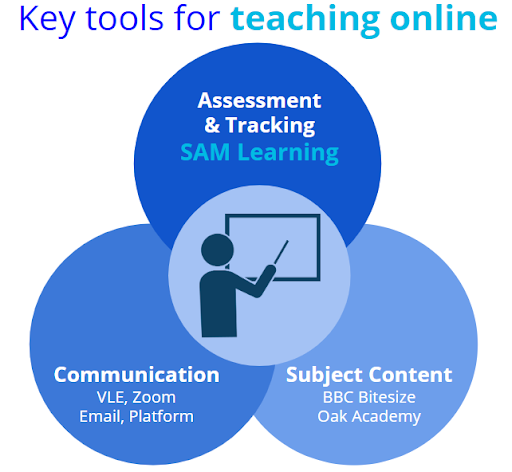Have you seen this from the DFE?

The DfE published on the 15th December 2020, asking Schools to share relevant information with pupils and parents or carers about how they will provide remote education.
The information should be published on school websites by 25 January 2021 to support understanding of what pupils, parents, and carers should expect during periods of a school closure or pupil isolation relating to coronavirus (COVID-19).
This article explains how SAM Learning provides essential elements of Remote Education.
The remote curriculum: what is taught to pupils at home
What should my child expect from immediate remote education in the first day or two of pupils being sent home?
SAM Learning isn’t just for Lockdown. Schools who use us regularly for Review and Assessment (whether revision or homework) will have a smooth transition to using us remotely.
If a teacher is unable to set work immediately, parents can refer to their child’s timetable – and ask them to find relevant activities to do on SAM Learning.
Following the first few days of remote education, will my child be taught broadly the same curriculum as they would if they were in school?
Relevant activities can be set as part of any remote learning scheme – whether to link with prior learning or to support the consolidation of new content.
Teachers will be able to see live reporting as learners complete their work remotely.
Remote teaching and study time each day
How long can I expect work set by the school to take my child each day?
SAM Learning activities typically take 10 to 15 minutes each – so one or two can fit nicely into a lesson; 2 or 3 make up a good week’s homework.
Accessing remote education
How will my child access any online remote education you are providing?
SAM Learning is online – and can be accessed from any device with a browser: Desktop, Laptop, Tablet… even phones.
If my child does not have digital or online access at home, how will you support them to access remote education?
SAM Learning can be accessed from pretty much any mobile device, even smart phones, if the screen is large enough.
But also… research has shown that disadvantaged learners make even greater progress with SAM Learning, so it’s definitely worth doing what you can to get it to them.
How will my child be taught remotely?
Teachers can insert links to SAM Learning activities into their lesson plans / teaching activities. (Every activity has its unique URL.)
Learners can also complete any SAM LEarning activity of their own choice – e.g. to review last year’s work before moving a topic forward.
Our activities can also be set through other platforms (Google Classroom, MS Teams, SMHW / Satchel…)
Engagement and feedback
What are your expectations for my child’s engagement and the support that we as parents and carers should provide at home?
We know that 2 SAM Learning tasks a week leads to over 10 hours across the year – which has been shown by FFT / EEF to lead to a likely +0.2 on Progress 8 scores.
Teachers will receive the results of this work automatically.
How will you check whether my child is engaging with their work and how will I be informed if there are concerns?
Teachers can check at any time how well learners are getting on with SAM Learning:
- Progress Reports show how much work they are doing – and how well.
- Task Reports are emailed to teachers when deadlines are reached.
How will you assess my child’s work and progress?
Pupils receive immediate feedback on work completed on SAM Learning. Teachers will receive reports on work done and will work to identify ‘next steps’, based on their scores.
Additional support for pupils with particular needs
How will you work with me to help my child who needs additional support from adults at home to access remote education?
SENDCOs in SAM Learning schools can set up “Wave 2 – School Intervention” Groups so that they can closely monitor the work of their learners. They can also use these groups to target the usual “Targeted Intervention” catchup activities that they would do in support sessions.
Remote education for self-isolating pupils
If my child is not in school because they are self-isolating, how will their remote education differ from the approaches described above?
SAM Learning allows teachers to target Review and Assessment work at individuals as appropriate. This will be particularly useful to check that pupils are keeping up with their studies and to quickly identify any learning gaps.
If you would like to discuss further or arrange an online demonstration, please get in touch here.